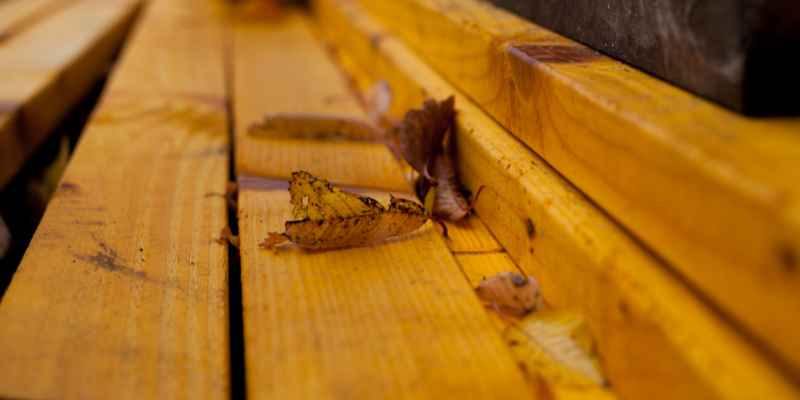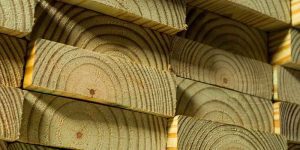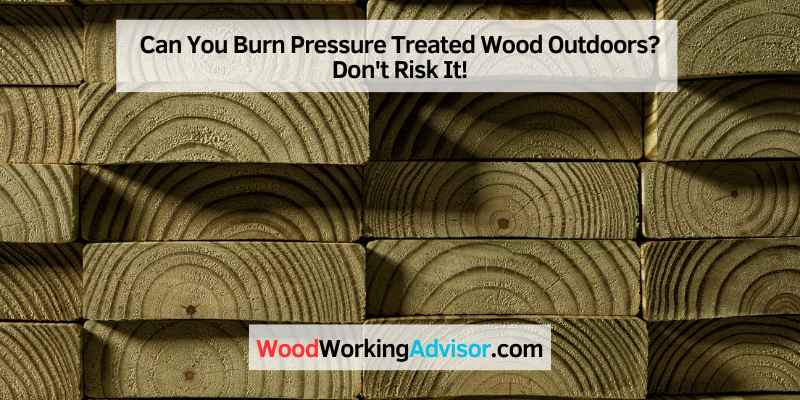No, you should never burn pressure treated wood outdoors. Burning this type of wood releases hazardous chemicals, including arsenic, which poses a significant danger to both human health and the environment.
It is crucial to take steps to dispose of pressure treated wood safely to prevent potential harm. Pressure treated wood is a common construction material that has been treated with chemicals to prevent decay and termite damage. However, the toxicity of these chemicals makes it hazardous to burn pressure treated wood.
Even small amounts of the ash left behind after burning can be dangerous. If possible, it is the best practice to avoid burning the wood altogether and find alternative means of disposal. We will explore the dangers associated with burning pressure treated wood and offer safe disposal options.
The Danger Of Burning Pressure Treated Wood
Burning pressure treated wood outdoors can be dangerous to your health and the environment. Pressure treated wood contains chemicals like arsenic, which are released into the air when burned and can cause serious respiratory problems. It is important to dispose of pressure treated wood responsibly instead of burning it.
What Happens When You Burn Pressure Treated Wood?
Burning pressure treated wood is dangerous for various reasons. When you burn pressure treated wood, the heat breaks down the chemical compounds present in the wood, releasing toxic fumes and ash. It results in the liberation of harmful chemicals such as arsenic, copper, and chromium, making the smoke and ash of the burnt wood toxic.
The Health Hazards Of Burning Pressure Treated Wood
The chemicals released from the burnt pressure treated wood can cause serious health problems like respiratory issues, skin irritation, headaches, dizziness, and nausea. Prolonged exposure to these toxic chemicals can lead to life-threatening diseases like cancer, liver and kidney damage, and central nervous system disorders.
Proper Disposal Of Pressure Treated Wood
To avoid the harmful effects of burning pressure treated wood, proper disposal is crucial. The treated wood of all types should be disposed of responsibly. Homeowners should take the treated wood to their designated landfill or transfer station and place it in the non-clean wood pile. Moreover, before taking the treated wood to the landfill, ensure that it is not painted, laminated, or stained.
To treat pressure treated wood for outdoor use, one should use a clear protective coating for sealing it. This protective coating will prevent any chemicals from leaching out of the wood due to rain or snow, making it safe for outdoor use.
In a nutshell, burning pressure treated wood outdoors can release toxic chemicals into the air, leading to severe health hazards. Therefore, proper disposal and treatment are necessary to ensure a safe environment for everyone.
Identifying Pressure Treated Wood
Burning pressure treated wood outdoors is not recommended as it releases harmful chemicals. To identify pressure treated wood, look for a greenish tint and characteristic dimples or holes resembling staple holes. Properly dispose of it at a local landfill or transfer station.
When it comes to outdoor projects, pressure treated wood is common due to its ability to withstand harsh weather conditions. However, burning pressure treated wood is a serious health hazard. Before embarking on any outdoor burning project, it’s crucial to identify the type of wood you are dealing with to avoid potential health risks.
What is Pressure Treated Wood?
Pressure-treated wood refers to wood that has been treated with chemicals to make it more resistant to rot, insects, and other environmental factors that can cause decay. Typically, pressure-treated wood has a greenish tint and small holes or dimples that resemble staple holes. The wood is treated using chromated copper arsenate (CCA) or another type of chemical that contains arsenic.
Why You Should Avoid Burning Pressure Treated Wood
It’s important to note that burning pressure-treated wood is hazardous and should be avoided at all costs. When burned, the chemicals in the wood release dangerous toxins and carcinogens that can negatively impact respiratory health and lead to cancer. In addition, burning pressure-treated wood can harm the environment, polluting the soil, air, and water.
What to Do with Pressure Treated Wood
Rather than burning pressure treated wood, consider alternative methods of disposal. Homeowners can take treated wood to their local landfill or transfer station and place it in the designated location (i.e., the non-clean wood pile). Ultimately, it’s crucial to avoid burning pressure-treated wood and opt for safer disposal methods to protect your health and the environment.
Alternatives To Burning Pressure Treated Wood

Burning pressure treated wood outdoors is not recommended, as it releases harmful chemicals into the air. Alternatives include using untreated wood or composite materials for outdoor structures or repurposing scrap pressure treated wood responsibly by taking it to a designated landfill or transfer station.
If you’re concerned about the potential health risks associated with burning pressure treated wood outdoors, consider the following alternatives that are safer, more effective, and environmentally friendly.
Premium Firewood Options
Premium firewood options are a great alternative to burning pressure treated wood outdoors. These firewood options are made from renewable resources, such as hardwood and softwood, and are untreated with chemicals, making them safe and eco-friendly.
Considerations for Outdoor Wood Burning
If you choose to burn untreated wood outdoors, keep in mind that there are some considerations to ensure safety and compliance with local regulations. Here are some important points to consider when burning wood outdoors:
– Use a proper fire pit or stove: Ensure that the fire pit or stove is in good condition and is large enough to contain the fire.
– Choose the right location: Choose a well-ventilated area that is far away from any buildings or combustible materials.
– Check the weather conditions: Check the weather forecast before burning wood outdoors. Avoid burning on windy or dry days.
– Be prepared: Always have a fire extinguisher, water hose, or container of water nearby in case of an emergency.
Disposing of Pressure Treated Wood
If you have pressure treated wood that needs to be disposed of, it’s important to follow the correct procedures to ensure that this hazardous material doesn’t harm the environment. Here are some responsible ways to dispose of pressure treated wood:
– Take the treated wood to a landfill or transfer station: Many local landfills or transfer stations have a designated area for treated wood.
– Recycle the treated wood: Some recycling centers will accept pressure treated wood for recycling.
– Repurpose the treated wood: Repurpose the treated wood for non-structural projects such as garden beds or compost bins.
In conclusion, burning pressure treated wood outdoors is not a safe or environmentally friendly option. Instead, consider using premium firewood or other alternatives, and safely dispose of pressure treated wood using responsible methods.
Treatment And Maintenance For Pressure Treated Wood
It’s best not to burn pressure-treated wood outdoors. This type of wood is considered hazardous as it contains chemicals like arsenic, which can be released into the air when burned. Proper disposal methods include taking it to a designated location at your local landfill or transfer station.
When To Treat Outdoor Wood
Pressure treated wood is highly resistant to rot and decay, but it does require regular maintenance. The amount of maintenance required depends on a few factors, including the climate and how much exposure to the elements the wood receives. As a general rule, outdoor wood should be treated every one to three years. Signs to look out for that indicate your pressure treated wood needs maintenance include:
- Discoloration or fading
- Cracking, warping, or splitting
- Mildew or mold growth
Maintenance Tips For Pressure Treated Wood
Proper maintenance can help extend the lifespan of pressure treated wood. Here are some maintenance tips to keep in mind:
- Clean the wood regularly using a mild soap and water solution to remove dirt and debris
- Apply a water-repellent sealant to protect the wood and prevent moisture absorption
- Use a wood preservative to help prevent fungal growth and insect damage
- Inspect the wood regularly for signs of damage and replace any damaged sections as soon as possible
Outdoor Wood Treatment Safety Tips
When treating pressure treated wood, it is important to take safety precautions to protect yourself and those around you. Here are some safety tips to follow:
- Wear gloves, goggles, and a dust mask to protect yourself from chemicals
- Avoid applying wood treatments on windy days to prevent the chemicals from blowing away
- Ensure proper ventilation when working with wood treatments
- Follow the manufacturer’s instructions for proper use and application of wood treatments
In conclusion, pressure treated wood can be burnt, but it is not recommended due to the chemicals it releases. With regular maintenance and proper treatment, you can extend the life of your outdoor wood for years to come.

Frequently Asked Questions On Can You Burn Pressure Treated Wood Outdoors
What Happens If You Burn Pressure Treated Wood?
Burning pressure treated wood should be avoided as it is considered hazardous waste and releases the chemical bond that holds arsenic in the wood. Just one tablespoon of ash from burnt treated wood contains a lethal dose of poison. It should be disposed of responsibly at a local landfill or transfer station in the designated location for non-clean wood.
Never burn pressure-treated wood, which can produce harmful chemicals when burned.
What Can You Do With Scrap Pressure Treated Wood?
Scrap pressure treated wood should not be burned as it releases hazardous chemicals like arsenic. Homeowners should take it to their local landfill or transfer station and place it in the designated location. Treated wood of all types can be responsibly discarded this way.
Burning pressure-treated wood is not recommended as it produces harmful chemicals.
Can You Use Treated Wood In A Bonfire?
No, pressure-treated wood should never be burned in open fires, including bonfires. Burning this wood releases chemicals that can be harmful to human health and the environment. Treated wood should be disposed of responsibly, either by taking it to a designated location at a landfill or transfer station, or using it for alternative purposes such as building materials.
How Do You Treat Pressure Treated Wood For Outdoor Use?
Burning pressure-treated wood for outdoor use is not recommended, as it contains toxic chemicals. Disposing of treated wood should adhere to local guidelines such as taking it to designated locations in landfills. Avoid burning garbage, plastic, and copper-containing pressure-treated wood.
Opt for using premium firewood instead.
Conclusion
Burning pressure treated wood outdoors is not recommended due to the potential release of hazardous chemicals, such as arsenic. The proper disposal of pressure treated wood should be followed, such as taking it to a designated landfill or transfer station.
It is important to be aware of the greenish tint and characteristic dimples or holes that indicate pressure treated wood. It is always better to err on the side of caution and burn premium firewood instead.


